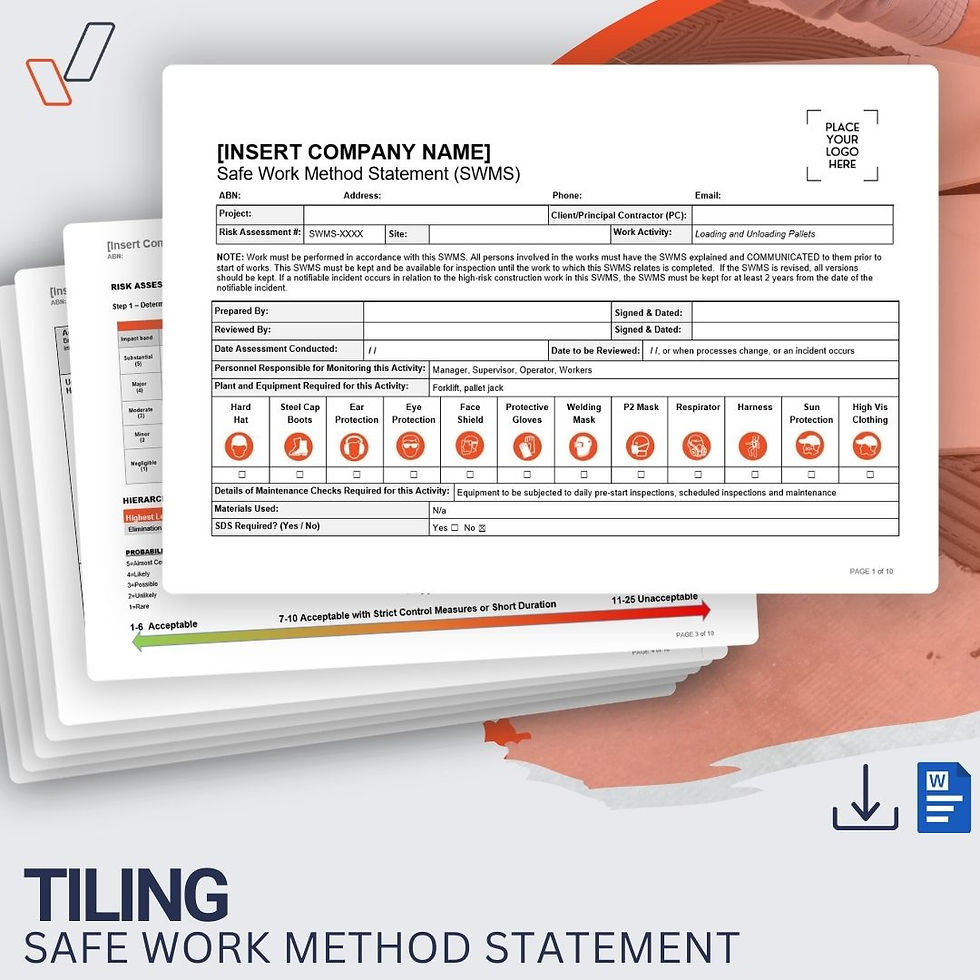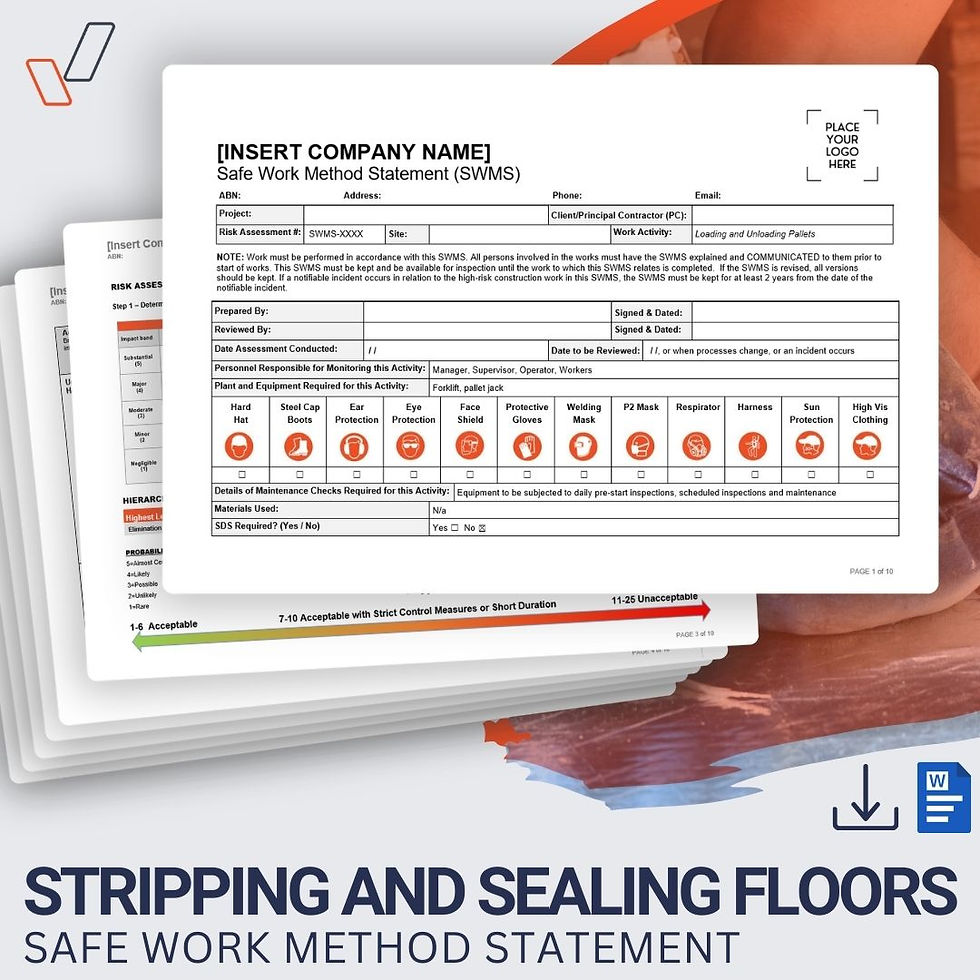This 28-page Solar Installation Safe Work Method Statement (SWMS) provides comprehensive safety controls and identifies potential hazards associated with installing solar panels and related electrical components. Designed by WHS experts, this pre-filled template assists your business in meeting its WHS obligations while helping to ensure compliance with Australian safety legislation.
Suitable for all Australian states and territories, the template is fully editable, making it easy to customise with your company name, logo, and site-specific details. Perfect for tender submissions, safety audits, and on-site compliance, this SWMS saves you time while helping to keep your team safe and your business protected.
Who This SWMS Is For
This SWMS is suitable for a wide range of businesses and industries, including:
Solar installation companies
Electrical contractors
Roofing contractors
HVAC and renewable energy specialists
Builders and construction companies
Maintenance and service providers
Warehousing and logistics businesses
Facilities management teams
What This SWMS Covers
This SWMS includes detailed step-by-step safety procedures, hazards, and control measures for solar installation, including:
General Site Hazards
Workers unaware of site-specific risks or overlapping trades.
Controls: Pre-start risk assessments, inductions, toolbox talks, and coordination with other contractors.
Personal Protective Equipment (PPE)
Risk of injury, illness, or disability without correct PPE.
Controls: Provision and mandatory use of hard hats, safety boots, gloves, eye and ear protection, respirators (P2 masks), high-vis clothing, and fall arrest harnesses.
Working in Hot Conditions
Heat stress, dehydration, sunburn, and fatigue.
Controls: Scheduled rest breaks, hydration (0.5L water per hour), use of SPF50+ sunscreen, sun-protective clothing, shaded rest areas, and training to recognise heat-related symptoms.
Housekeeping and Access Hazards
Slips, trips, and falls from uneven, steep, or slippery surfaces.
Controls: Keep walkways clear, regular housekeeping, barricades around hazards, correct footwear.
Manual Handling
Sprains, strains, back injuries, and crushing injuries from lifting panels or equipment.
Controls: Training in correct lifting techniques, use of panel lifts/hoists, rotating tasks, using mechanical aids for repetitive or heavy lifts.
Electricity and Power Tools
Electrocution, burns, lacerations, entanglement, and hearing loss.
Controls: Electrical isolation/tag-out by licensed electricians, RCD protection, tested/tagged tools, guarding in place, correct PPE (gloves, hearing protection, safety glasses), safe tool handling training.
Working Near Energised Services
Electrocution or fire when installing or connecting panels.
Controls: Isolation of circuits, testing for dead, lockout/tagout, treating non-isolated circuits as live, keeping flammable materials away from electrical systems, correct fire extinguishers available.
Working at Heights
Falls from roofs, ladders, scaffolds, or EWPs, plus risk of falling tools/materials.
Controls: Height safety training, inspected harnesses and anchor points, exclusion zones below work areas, compliant ladder selection and setup (AS 1892), use of EWPs by licensed operators, weather monitoring (no work in rain/wind).
Installation Activities
Hazards when installing PV modules, drilling, mounting frames, installing conduits and cabling.
Controls: Correct use of tools and equipment, dust control measures (wet cutting, on-tool extraction, respirators for RCS dust), use of gloves for sharp objects, barricading work zones, securing loose cables immediately.
Environmental Conditions
Dust, noise, and waste from drilling and cutting.
Controls: Dust suppression methods, PPE (P2 masks, hearing protection), waste segregation and disposal procedures.
Emergency Preparedness
Inadequate response to accidents, incidents, or electrical shocks.
Controls: Emergency procedures in place and briefed at induction, muster points identified, AED and first aid kits on-site, trained first aiders, communication devices (radios/mobiles), annual emergency drills.
End of Workday / Completion
Risks from unsecured tools, waste materials, and incomplete works.
Controls: Remove excess materials, tidy work area, secure equipment, lock storage areas, final inspection and sign-off.
What’s Included in Your Template
HRCW Selection Table
Risk assessment guidelines and risk rating calculator
Step-by-step procedures and safety controls
Detailed hazards and control measures
PPE requirements and selection guidance
Plant and equipment checklist
Relevant legislation, codes, and Australian Standards
Worker sign-off page
This Solar Installation SWMS template is an essential tool for documenting your WHS systems and helping to maintain WHS compliance. Designed for quick editing and easy customisation, it adapts seamlessly to your operational needs - making it a valuable addition to your safety management toolkit.
Perfect for tenders, safety audits, and day-to-day operations, this template saves you time and helps ensure your team is safe and your business remains compliant.
Get your Solar Installation SWMS today and start using it instantly!
Solar Installation SWMS
We accept the following payment methods:
➡️ Pre-filled and ready to use
➡️ Created by WHS experts, aligned with Australian WHS legislation
➡️ Suitable for all Australian states and territories
➡️ Fully editable Microsoft Word format
➡️ Instant delivery via email
➡️ Free list of relevant legislation & codes of practice (valued at $19.95)
➡️ Easy customisation instructions included
➡️ Pay once, use it as many times as you need
➡️ 12 months free phone and email support


















